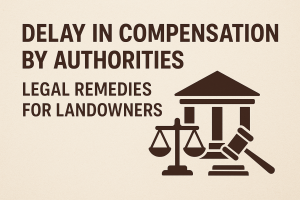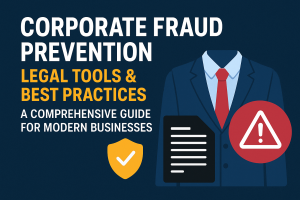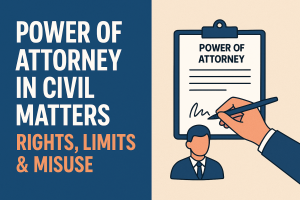Introduction
Bankruptcy is not just a financial concept—it’s a legal process designed to provide relief to debtors and fair distribution of assets to creditors. In this process, two important entities play critical roles in ensuring balance and integrity: the Bankruptcy Trustee and the Creditors’ Committee. Both are essential to administering the bankruptcy case efficiently, ensuring compliance with legal frameworks, protecting stakeholders’ rights, and facilitating restructuring or liquidation. This blog offers a deep dive into the roles, powers, responsibilities, and significance of these two pillars of insolvency proceedings, especially in the context of Indian and global practices.
Who is a Bankruptcy Trustee?
A Bankruptcy Trustee is an individual or professional entity appointed to oversee the debtor’s estate during insolvency proceedings. In India, under the Insolvency and Bankruptcy Code, 2016 (IBC), the term “Insolvency Professional” (IP) or “Resolution Professional” (RP) is used for similar roles. In liquidation cases, the appointed professional is called a “Liquidator.”
Key Responsibilities:
- Asset control and custody: The trustee takes over the control and custody of the debtor’s assets.
- Evaluation of claims: Verifies and categorises claims submitted by creditors.
- Asset realisation : Collects and sells the assets of the debtor in case of liquidation.
- Distribution of proceeds: Distributes realised assets among creditors as per the legal waterfall mechanism.
- Legal compliance: Files necessary reports, disclosures, and ensures procedural compliance with NCLT (National Company Law Tribunal) or relevant adjudicating authority.
The trustee acts as a neutral party with a fiduciary duty to both the debtor and the creditors, ensuring a transparent and equitable process.
Types of Bankruptcy Trustees
- Resolution Professional (RP): Appointed during the Corporate Insolvency Resolution Process (CIRP). Their goal is to manage the debtor as a going concern and facilitate the creation of a resolution plan.
- Liquidator: Appointed when resolution fails and the company proceeds into liquidation. Their role is to sell assets and distribute proceeds.
- Bankruptcy Trustee (in personal insolvency cases): In personal insolvency, the trustee administers the estate of an individual who is declared bankrupt.
Who Forms the Creditors’ Committee?
The Committee of Creditors (CoC), particularly under India’s IBC, comprises financial creditors (banks, financial institutions, NBFCs) of the corporate debtor. Operational creditors may attend meetings but do not have voting rights unless they meet a certain threshold.
Formation Process:
- Formed after admission of insolvency proceedings.
- Only financial creditors with validated claims are included.
- Led by the Resolution Professional who calls for CoC meetings and facilitates decision-making.
Role of the Creditors’ Committee
The CoC plays a central role in the resolution or liquidation process. It acts as the decision-making body on all key matters.
Key Functions:
- Evaluate and approve resolution plans.
- Decide on continuation or replacement of the Resolution Professional.
- Approve interim finance, if required.
- Make crucial decisions such as liquidation, extension of CIRP period, etc.
- Supervise the conduct of the RP.
All decisions are taken by vote, typically requiring at least 66% voting share unless otherwise specified.
Interaction Between Trustee and Creditors’ Committee
The Trustee (or RP) and the CoC must work in close coordination. The RP reports to the CoC, presents critical financial and legal updates, and executes decisions passed by the committee. While the CoC has commercial wisdom, the RP ensures procedural and legal compliance.
The trustee facilitates:
- Regular meetings and voting processes of the CoC.
- Presentation of resolution plans received from prospective resolution applicants.
- Implementation of approved plans.
The CoC, in turn, oversees and guides the process, ensuring that the debtor’s estate is preserved and maximised .
Importance of Their Roles in the Bankruptcy Ecosystem
Both the trustee and the creditors’ committee are pivotal for several reasons:
- Transparency and Fairness: Their interaction ensures checks and balances in decision-making.
- Stakeholder Protection: Creditors’ interests are safeguarded while maintaining the integrity of the process.
- Efficient Resolution: With professional expertise and creditor consensus, outcomes are more balanced and timely.
- Maximisation of Value: Asset realisation and plan approval are optimised with stakeholder involvement.
Challenges Faced
Despite their importance, both entities face several practical hurdles:
- Delay in claim verification and plan submissions.
- Lack of cooperation from promoters or suspended board.
- Conflicts among different creditor groups.
- Legal hurdles and multiple litigations.
- Insufficient professional experience of trustees in complex cases.
Global Perspective: How It Works Internationally
In jurisdictions like the U.S. under Chapter 11 of the Bankruptcy Code:
- A trustee may be appointed for cause or in specific circumstances.
- Creditors’ Committees are formalized and often represented by legal and financial advisors.
In the UK, an “insolvency practitioner” assumes the trustee role, and committees are less prominent but still engaged in oversight.
Conclusion
The Bankruptcy Trustee and Creditors’ Committee together form the backbone of an efficient insolvency process. Their collaboration ensures the principles of equity, transparency, and maximisation of value are upheld. As India continues to strengthen its insolvency regime, the importance of skilled trustees and responsible creditor committees cannot be overstated. For stakeholders, understanding the dynamic between these two entities is vital to navigating or participating in the bankruptcy process effectively.
If you’re a business, creditor, or legal professional involved in insolvency cases, staying informed about these roles can help you protect your rights and take proactive steps toward recovery or compliance.



